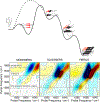Two-Dimensional Spectroscopy Is Being Used to Address Core Scientific Questions in Biology and Materials Science
- PMID: 29346730
- PMCID: PMC6400462
- DOI: 10.1021/acs.jpcb.7b11370
Two-Dimensional Spectroscopy Is Being Used to Address Core Scientific Questions in Biology and Materials Science
Abstract
Two-dimensional spectroscopy is a powerful tool for extracting structural and dynamic information from a wide range of chemical systems. We provide a brief overview of the ways in which two-dimensional visible and infrared spectroscopies are being applied to elucidate fundamental details of important processes in biological and materials science. The topics covered include amyloid proteins, photosynthetic complexes, ion channels, photovoltaics, batteries, as well as a variety of promising new methods in two-dimensional spectroscopy.
Conflict of interest statement
The authors declare the following competing financial interest(s): Martin Zanni is co-owner of PhaseTech Spectroscopy, Inc., which sells mid-IR and visible pulse shapers and 2D spectrometers.
Figures




References
-
- Hamm P; Zanni MT Concepts and Methods of 2D Infrared Spectroscopy; Cambridge University Press: New York, 2011.
-
- Cho M Two-Dimensional Optical Spectroscopy; Taylor & Francis Group: Boca Raton, FL, 2009.
-
- Mukamel S Principles of Nonlinear Optical Spectroscopy; Oxford University Press: New York, 1995.
-
- Khalil M; Demirdöven N; Tokmakoff, a. Coherent 2D IR Spectroscopy: Molecular Structure and Dynamics in Solution. J. Phys. Chem. A 2003, 107 (27), 5258–5279.
Publication types
MeSH terms
Substances
Grants and funding
LinkOut - more resources
Full Text Sources
Other Literature Sources

